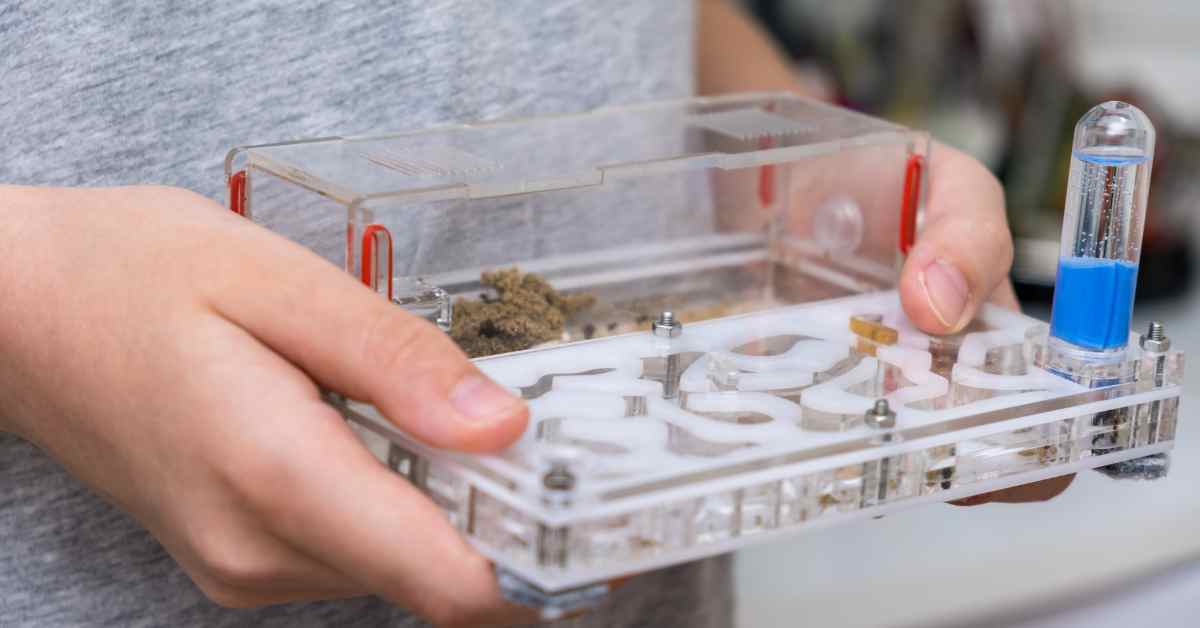Ants do not possess a complex respiratory system due to their smaller bodies and shorter lifespan. They require oxygen to live and reproduce, which means their survival is at risk when they do not breathe for long.
How Do Ants Breathe in an Ant Farm? Ants breathe through ventilation holes in an ant farm because they do not need large quantities of oxygen to energize their bodies. They use spiracles in the exoskeleton and store oxygen in tracheal tubes by closing spiracles that can keep them alive for almost a day.
You should design ant farms by keeping their requirements for oxygen in mind; otherwise, you will lose your pet colony in a short time.
How do ants get air in an ant farm?
We have seen ants living inside a close setup artificially designed to mimic their natural habitat, lacking direct exposure to air.
They are tiny insects requiring a smaller amount of oxygen to keep their bodies in a functioning state. They can live inside a sealed container for many hours without getting oxygen.
The ant farms are adequately covered to minimize the escape routes because these insects are efficient escapers and make their way through holes.
Moreover, there are ventilation holes in the ant farm, allowing air circulation inside the farm to keep these ants alive because they cannot live without oxygen for too long.
The air inside the container can get stagnant when there is poor ventilation, leading to the death of insects because their metabolic functions depend on oxygen.
In addition, some people add a mesh cover on the top of the farm for gaseous exchange from inside the container to the outside environment and to maintain a balance.
The hole size of the mesh should be smaller than that of the ants’ body living inside the farm because they can sneak through holes and get out of the container.
The air molecules enter the glass tank through diffusion when the oxygen molecules move from higher to lower concentrations.
A concentration gradient develops, allowing carbon dioxide molecules to move outside the container and supporting the entry of oxygen molecules within it.
Furthermore, you have to ensure that nothing hinders the diffusion process from keeping the ant farm in running conditions, as lack of oxygen also affects the reproductive abilities of insects.
How long can ants survive in an ant farm?
The survival of ants in an ant farm depends on the conditions of the farm and their species because their lifespan varies among different species.
Farm conditions include the availability of food, water, or oxygen and the size of the container because a larger colony can feel suffocated within a small container.
In the same way, the workers in a fire ant colony can live for only 5 weeks, but pavement ants can survive for almost 4 to 5 years and complete their lifecycle.
Proper ventilation and air exchange promote longer lifespan if all the other conditions are also good. Any interference in air flow can decrease their survival rate.
The mesh or ventilation holes can clog due to poor cleaning practices, and the air passage can get blocked when it gets covered with any object.
Such blockage and clogging lead to airflow restriction and pose a risk to their survival, so you have to be careful and check the ventilation often.
They can only survive for 20 to 24 hours within an airtight container because their bodies store oxygen molecules to use when they cannot breathe.
So, you have to keep an eye on the oxygen level within an ant farm to keep insects alive because the colony cannot avoid death after a day.
Why do people think that ants can’t breathe in an ant farm?
Many people think that ants cannot breathe in an ant farm due to the absence of a respiratory system or lungs in their bodies, but they have their own breathing mechanisms.
Their bodies have tiny openings or spiracles for breathing purposes, allowing oxygen to get inside their bodies and carbon dioxide out of them.
This misconception arises due to the close structure of the farm, as the containers usually have a lid or a mesh on the top, having no larger holes for ventilation.
Many people do not know about ants’ breathing behavior; they think they cannot breathe inside a farm and live without oxygen.
It is not true because there are multiple tiny holes in the lid or upper edges of the glass container to ensure airflow within the glass container.
Larger holes can lead to an escape of these tiny insects; that’s why the farm is usually designed with tiny holes smaller than their body size.
Moreover, I kept a colony in a small glass jar at home and created tiny holes in the lid using a thin needle. These holes allow air to enter the jar and reach the ants’ bodies, and they can breathe easily.
In addition, there is a risk of suffocation in ants when they are kept inside an airtight or closed container because their bodies need oxygen to carry out functions.
You have to keep the ventilation holes in the ant farm clean to avoid accumulating dirt or debris, as these clogged holes can be responsible for colony death if they remain unnoticed.
Related Articles:

